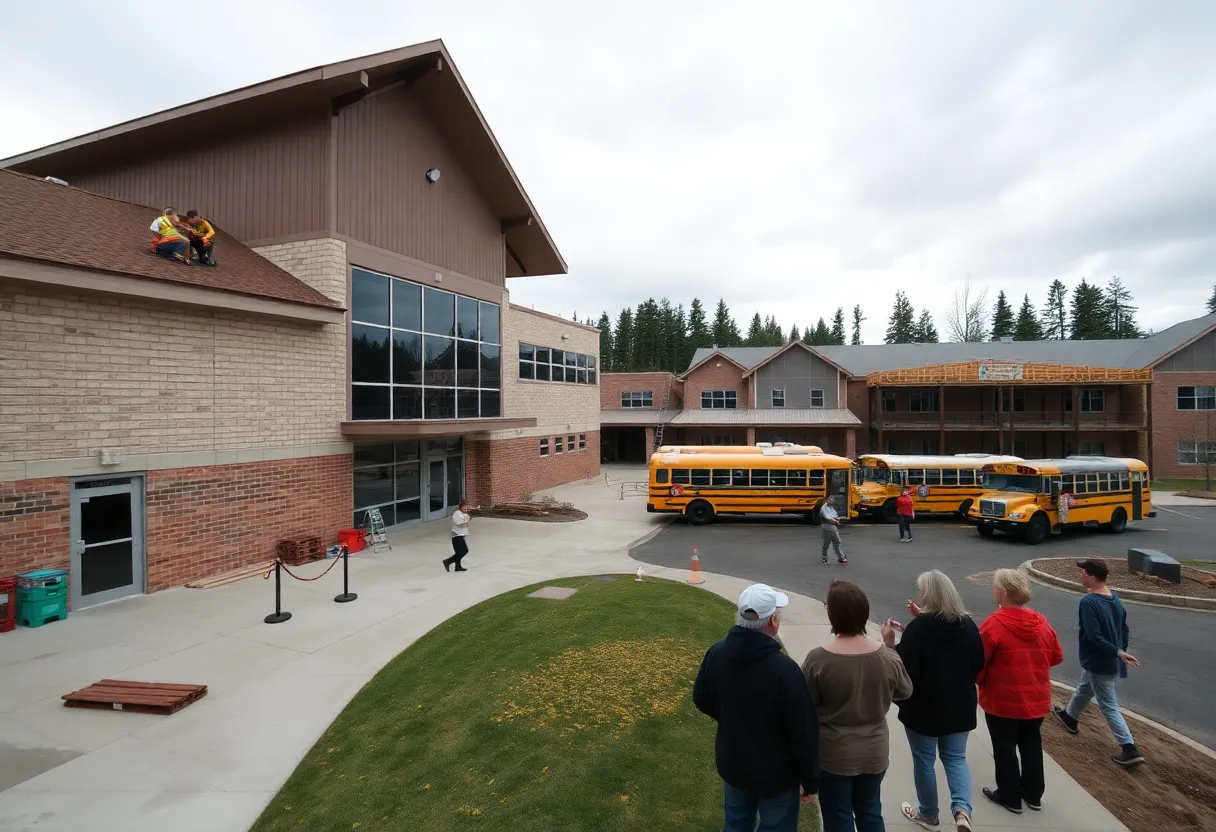Washington state, September 25, 2025
News Summary
Facing repeated failures of bond measures that require a 60% super‑majority, Washington school districts are pivoting to capital levies, grants and local partnerships to fund building repairs, safety upgrades and modest classroom additions. Levies, which need only a simple majority and run three to six years, provide phased cash flow that shapes project timing. Grants cover targeted, competitive needs and often require matching funds, while partnerships share costs and expand services. Districts are sequencing projects to levy receipts, tracking grant timelines and communicating visible results to build voter trust amid debate over property‑tax caps.
Washington districts shift from failed bonds to levies, grants and local partnerships
School districts across Washington are changing how they pay for buildings and safety work. After a string of high-profile bond failures, many districts are relying more on capital levies, state and federal grants, and partnerships with local agencies to keep roofs repaired, buses running and campuses safe. A recent attempt by state lawmakers to loosen a long-standing cap on property-tax growth was dropped, leaving local revenue tools and creative funding strategies front and center for districts facing urgent needs.
Why bonds are harder to pass
Voters must approve school bonds with a 60% super-majority, and that threshold has become difficult to reach in many communities. When bonds fail, districts lose access to certain state matching programs tied to large capital campaigns, and they must look for other ways to raise money. The decline in bond passage has also reduced the pool of requests to the state for matching funds.
Capital levies: a quicker, smaller-scale tool
Capital levies require a simple majority to pass and usually run for 3–6 years, compared with bonds that stretch 20–30 years. Levies collect money twice a year instead of delivering a lump sum, so districts must plan cash flow carefully. That schedule often makes levies a better fit for urgent fixes and medium-sized projects — think of a car loan versus a home mortgage. Typical levy-funded work includes security cameras, access controls, reroofs, playground repairs, and smaller classroom additions.
Example: a district rebuilds trust with levies
One district in eastern Washington had a bond to replace three schools fail in 2024. Leaders turned to capital levies to tackle pressing repairs and to add small classroom wings to handle growing enrollment. After passing an initial levy and then a follow-up measure, the district will now build separate bus loops to reduce traffic congestion and create safer drop-off zones. Those projects were used to show voters that local tax dollars were being spent responsibly, helping restore community confidence for later measures.
Grants fill gaps and fund targeted work
With bond requests down, some grant pots have opened for districts. Grants can fund planning studies, system replacements like HVAC upgrades, seismic work, environmental remediation, and testing for lead in water. Many grants have two phases: a planning grant to define need and budget, followed by capital or construction funding. Grants often favor small, rural, tribal, or growing early-learning programs and sometimes require a district match or in-kind contribution. Because grant timelines stretch across budget cycles, they may not always line up with urgent needs — though specific urgent repair grants at the state level can.
Partnerships stretch local tax dollars
Districts are also teaming up with public libraries, parks departments and health providers to share space and split development and operating costs. Shared projects can include co-located libraries, on-campus health clinics, and joint athletic fields. Partnerships can reduce long-term expenses, improve student access to services and sometimes make projects eligible for a wider set of grants by diversifying ownership or management.
State policy drama and local effects
At the state level, lawmakers recently dropped a bid to raise the annual property-tax growth cap from 1% to as much as 3% after pushback from the governor and some lawmakers. That move means local governments and school districts must continue to rely mainly on voter-approved levies, bonds and other revenue streams. Local officials argue the 1% cap limits funding for services, while opponents warn higher caps would increase costs for homeowners.
Local levy races show the stakes
Smaller districts continue to see tight votes. In several rural districts, levies for programs, operations and capital improvements failed by narrow margins, costing nearly $10 million in planned investment in some areas. In one district, a replacement levy that would have cost the owner of a $400,000 home about $600 a year fell short by a few dozen votes. Another district’s capital levy for technology and security improvements would have been about $92 a year for the same home value and also failed by a narrow margin. Those close losses have real effects: some districts have cut staff and programs and are weighing deeper reductions or new ballots.
What districts need to do
Districts are balancing short-term repairs and long-term plans. Successful strategies include careful cash-flow planning for levies, early and realistic grant planning, and building visible partnerships that deliver services to students. Leaders say showing how money translates to safer, better learning spaces helps build voter trust — and that clear communication is essential for future votes and partnerships.
Bottom line
As bond success rates fall, Washington school districts are moving toward a mix of capital levies, targeted grants, and local partnerships to meet urgent facility needs. Each tool has trade-offs: levies pass more easily but provide money over time; grants can pay for specific work but take planning; partnerships can broaden resources but require coordination. For districts facing aging buildings and limited state options, combining these tools is becoming the practical path forward.
Frequently Asked Questions
What is the difference between a bond and a capital levy?
A bond is a long-term loan for big projects and needs a 60% voter approval. A capital levy is a shorter-term tax measure, usually 3–6 years, and needs a simple majority to pass. Bonds give cash up front; levies collect money over time.
When should a district choose a levy over a bond?
Choose a levy for urgent repairs, medium-sized projects, or when voters are unlikely to approve a large bond. Levies work well for safety upgrades, reroofs, playground fixes and small additions.
How can grants help districts?
Grants can fund planning studies, system upgrades, seismic and environmental work, and emergency repairs. Many grants require a planning phase before capital funds and may need a local match.
What role do partnerships play?
Partnerships with libraries, parks, health providers and others can share costs, expand services for students, and improve grant eligibility. They can also help communities get more use from shared facilities.
What happens if a bond fails?
If a bond fails, districts lose access to the lump-sum funding and may not qualify for certain state matching programs tied to bond campaigns. Districts often return with levies, seek grants, or form partnerships to meet needs.
{
“@context”: “https://schema.org”,
“@type”: “FAQPage”,
“mainEntity”: [
{
“@type”: “Question”,
“name”: “What is the difference between a bond and a capital levy?”,
“acceptedAnswer”: {
“@type”: “Answer”,
“text”: “A bond is a long-term loan for big projects and needs a 60% voter approval. A capital levy is a shorter-term tax measure, usually 3–6 years, and needs a simple majority to pass. Bonds give cash up front; levies collect money over time.”
}
},
{
“@type”: “Question”,
“name”: “When should a district choose a levy over a bond?”,
“acceptedAnswer”: {
“@type”: “Answer”,
“text”: “Choose a levy for urgent repairs, medium-sized projects, or when voters are unlikely to approve a large bond. Levies work well for safety upgrades, reroofs, playground fixes and small additions.”
}
},
{
“@type”: “Question”,
“name”: “How can grants help districts?”,
“acceptedAnswer”: {
“@type”: “Answer”,
“text”: “Grants can fund planning studies, system upgrades, seismic and environmental work, and emergency repairs. Many grants require a planning phase before capital funds and may need a local match.”
}
},
{
“@type”: “Question”,
“name”: “What role do partnerships play?”,
“acceptedAnswer”: {
“@type”: “Answer”,
“text”: “Partnerships with libraries, parks, health providers and others can share costs, expand services for students, and improve grant eligibility. They can also help communities get more use from shared facilities.”
}
},
{
“@type”: “Question”,
“name”: “What happens if a bond fails?”,
“acceptedAnswer”: {
“@type”: “Answer”,
“text”: “If a bond fails, districts lose access to the lump-sum funding and may not qualify for certain state matching programs tied to bond campaigns. Districts often return with levies, seek grants, or form partnerships to meet needs.”
}
}
]
}
Key features at a glance
| Funding Tool | Vote Required | Typical Duration | Best For | Cash Flow |
|---|---|---|---|---|
| Bond | 60% super-majority | 20–30 years | Large-scale replacements and new buildings | Lump-sum up front |
| Capital Levy | Simple majority (50%+) | 3–6 years | Urgent repairs, safety upgrades, small additions | Periodic collections over term |
| Grant | None (competitive) | Varies; often multi-year | Targeted projects, planning, system upgrades | Award-based, may require match |
| Partnership | Varies by partner | Long-term agreements common | Shared facilities, health and library services | Shared costs and responsibilities |
Deeper Dive: News & Info About This Topic
Additional Resources
- Washington State Standard: Washington Democrats abandon property-tax hike
- Wikipedia: Property tax
- The Center Square: Washington property-tax coverage
- Google Search: Washington property tax cap 2025
- Tri-City Herald: Local election and school funding coverage
- Google Scholar: Washington school bonds levies
- NBC Right Now: WA lawmakers debate property-tax reform bill
- Encyclopedia Britannica: Property tax
- KING5: Superintendent disappointed over legislature’s education bills funding levies
- Google News: Washington school levies 2025
Author: Construction CA News
The CALIFORNIA STAFF WRITER represents the experienced team at constructioncanews.com, your go-to source for actionable local news and information in California and beyond. Specializing in "news you can use," we cover essential topics like product reviews for personal and business needs, local business directories, politics, real estate trends, neighborhood insights, and state news affecting the area—with deep expertise drawn from years of dedicated reporting and strong community input, including local press releases and business updates. We deliver top reporting on high-value events such as the Rose Parade, Coachella, Comic-Con, and the California State Fair. Our coverage extends to key organizations like the California Building Industry Association and Associated General Contractors of California, plus leading businesses in technology and entertainment that power the local economy such as Apple and Alphabet. As part of the broader network, including constructionnynews.com, constructiontxnews.com, and constructionflnews.com, we provide comprehensive, credible insights into the dynamic landscape across multiple states.




